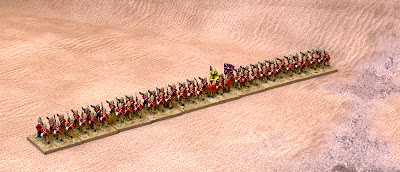So we start with the 21st Lancers. Nothing too much to say about them other than they painted quite easily. I did experiment with putting some lance pennons on - but making, cutting out the swallow tail and gluing them on would have been a punishment the Spanish Inquisition would have been proud of. So I stayed with the small red tassle (or something) that was cast at the top of the lance.
Remember I noted at the outset that I was mixing up the units that appeared in theatre and was not building for a specific year or campaign. In keeping with this relaxed approach, I know the British stopped taking their colours into the field a few years before the Sudan campaigns started - in 1881 during the Boer War. However, colours are colours and they make these units stand out - especially the khaki on the desert bases. After all, I am going to be playing a game - not making a documentary :)
So first we have the 1st Battalion of the York and Lancaster Regiment. They are dressed in khaki and will be the way a few more units are painted. A bit of googling showed me that the Regiment was formed in 1881 from an amalgamation of the 65th and 84th Regiments of Foot. As I could easily get my hands on Napoleonic Wars colours, I picked those of the 65th which were the most pleasant to my eye of the two.








Your Thin Red (and Khaki) Lines look great, Richard!
ReplyDeleteThanks for leaving the comment Jonathan. I am really enjoying doing them - probably about 4-5 months work in total for all including terrain.
Delete